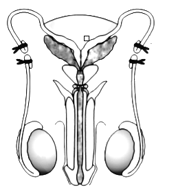Population Stabilization and Birth Control
Population Stabilization and Birth Control: Overview
This Topic covers sub-topics such as Vasectomy, Tubectomy, Oral Contraceptive Pills, Lactational Amenorrhea, Intrauterine Devices, Emergency Contraceptives, Birth Control, Contraceptive Implants, Barrier Methods of Birth Control and, Coitus Interruptus
Important Questions on Population Stabilization and Birth Control
Birth control tablets in females, popularly referred to as pills, prevent pregnancy by _____ .
After tubectomy can a woman get her period?
Assertion: For females, Saheli is an oral contraceptive pill containing nonsteroidal preparation.
Reason: Saheli is ‘once in a day’ pill with very few effects.
Assertion: Diaphragms and cervical caps are barriers made of rubber.
Reason: They block the entry of sperms through the cervix.
Identify the surgical method given in the below figure.

Fill in the blank with the correct answer from the bracket.
IUCDs makes the _____ move down the oviducts and uterus before fertilization. (sperm, egg, zygote)
Contraceptives do not cause any side effects.
Which of the following is/are the side effect/s of contraceptives?
Write a note on the side effects of IUCDs.
Which of the following is a side effect of contraceptives.
How contraception can be harmful to the health of women.
Which contraception method has the most harmful consequences?
A high dose of oral contraceptive pills can lead to pre-menstrual syndrome
What are the consequences of contraceptives?
Which of the following is the component of oral pills?
Which of the following is the component of oral pills?
Name the sterilization method used in human males. (Tubectomy/Vasectomy/hysterectomy)
Oral contraceptives are prescribed in the females to check the process of ovulation or lactation?
The hormone-releasing IUD is
Tubectomy involves cutting or tying of the vas deferens by a small incision in the abdomen.
